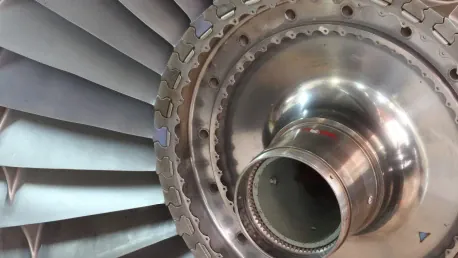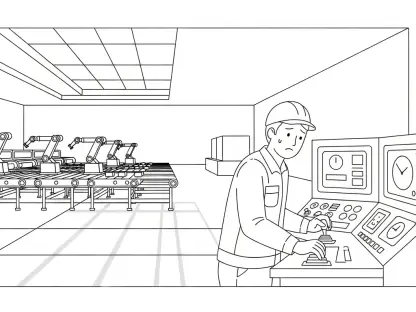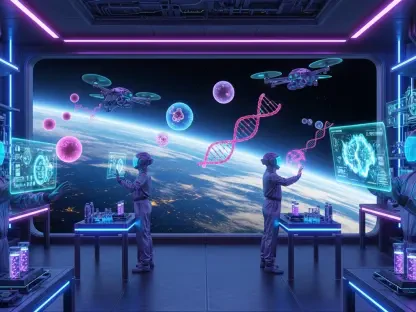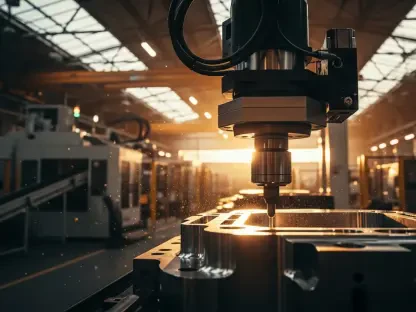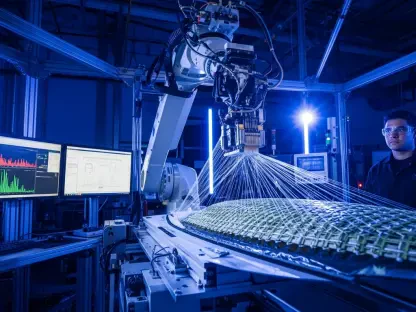The aerospace and defense industry has long been akin to a well-rehearsed symphony, where OEMs (Original Equipment Manufacturers) and prime integrators harmonize the inputs of myriad suppliers to create and support various platforms like airliners, submarines, and space launch vehicles. However, recent challenges, including delays, cost overruns, and quality issues, have thrown the industry into disarray. This troubling scenario has forced stakeholders to reassess and adjust their strategies, heralding a new era of reorganization.
A Historical Perspective: Contraction and Expansion
In the 1990s, the so-called “Era of Contraction” saw the industry shrink due to reduced defense budgets, resulting in widespread consolidation. Many companies either merged or were acquired, attempting to survive in a contracting market. This contraction phase gave way to an “Era of Expansion” in the 2000s and 2010s, marked by a sharp increase in commercial aerospace builds, significant Pentagon programs, and increased globalization.
Low-interest rates during these years fueled these expansions, resulting in considerable market investments. The industry landscape saw major players engaging in horizontal mergers and acquisitions, while new entrants also joined the fray. Complex supply chain agreements were formed, setting the stage for continued growth. The pre-pandemic era was one of considerable optimism, but the arrival of COVID-19 disrupted the industry heavily, necessitating a rethink of established strategies.
Before the pandemic reshaped the market, larger industry players had engaged in a flurry of horizontal mergers and acquisitions, creating a more interconnected and globalized supply chain. New entrants broke into the market, offering innovations and stirring competition. Supply chain agreements became more intricate and multifaceted, signifying an era poised for continued growth. However, the pandemic dramatically altered these conditions, bringing forth new pressures and challenges that signal the onset of what many experts now term the “Era of Reorganization.”
Key Pressures Driving the Reorganization
Three primary pressures are now driving what industry experts refer to as the “Era of Reorganization.” The first major pressure is the capability gap resulting from the exit of experienced engineering and technical talent, replaced by less experienced professionals. This shift has created noticeable reliability issues, shaking the foundation of long-standing supplier relationships and necessitating a reevaluation of internal capabilities.
The second pressure comes from escalating costs driven by inflation, supply chain disruptions, and unpredictable demand signals. Companies are now forced to invest in new capacities and next-generation platforms despite a challenging economic environment. Although the demand from commercial aerospace and defense sectors remains high, the financial strain on companies is palpable. Even as defense budgets nominally increase, real-term spending on procurements is at par with pre-pandemic levels, compelling companies to bear more investment costs themselves.
Lastly, capital allocators have become increasingly cautious in a world marked by heightened uncertainty and higher interest rates. Raising external funds has become a more arduous task, and internal R&D funds are dwindling due to reduced buying power and higher return expectations. This scenario compels companies to rethink their business plans, focusing on core activities while considering potential divestitures. The availability of capital is becoming a significant bottleneck, driving companies to reassess which projects to prioritize and where to cut back.
Strategies for Reorganization and Adaptation
To navigate these pressures, the industry must embrace new partnerships, revise supply relationships, and engage in mergers and acquisitions. One vital strategy involves securing the supply chain while reducing costs and reexamining buy-versus-build decisions. Major acquisitions like Boeing’s purchase of Spirit AeroSystems and Lockheed Martin’s acquisition of Terran Orbital suggest emerging trends in the industry. The aim is to strengthen internal capabilities and minimize supply chain dependencies.
Companies such as SpaceX and Anduril Industries highlight the advantages of increased vertical integration. As funding gaps become more apparent and work packages realign, the sector may witness vertical moves or accelerated consolidation among numerous businesses. This vertical integration model can reduce dependencies on external suppliers, lower costs, and enhance agility in adapting to market changes and external shocks.
Over the past two decades, the industry has experienced extensive horizontal mergers and acquisitions, resulting in large, diversified conglomerates. Companies like L3Harris Technologies, RTX, and Safran have undertaken significant divestitures—about 30 times since 2020. Horizontal integration, while beneficial in creating diversified portfolio businesses, now seems poised for a shift. Vertical integration, where companies bring more capabilities in-house, is gaining traction as a more resilient and cost-efficient model in the face of current pressures.
Vertical Integration: A New Paradigm
The shift towards vertical integration signifies a new paradigm in the aerospace and defense industry. Companies like SpaceX have showcased the benefits of this approach, serving as a blueprint for other industry players. By bringing more capabilities in-house, these companies minimize dependencies on external suppliers, reduce costs, and improve their agility. This model prepares firms better to withstand external shocks and adapt to market changes quickly.
Vertical integration not only decreases dependency on fragmented supplier networks but also offers cost benefits and greater control over the production process. This control is crucial for maintaining quality and reliability in an industry where both factors are paramount. For companies that successfully implement this model, the reduced need to rely on external investments and the ability to reallocate internal funds more efficiently offer a significant competitive edge.
The success of SpaceX and other vertically integrated companies could pave the way for a broader industry shift. As more firms adopt this model, it will likely prompt a reevaluation of traditional supply chain relationships and trigger a wave of mergers and acquisitions focused on bringing capabilities in-house. This trend towards vertical integration represents a strategic pivot, aligning with the need for agility, cost-efficiency, and enhanced reliability in a rapidly changing market environment.
The Role of Innovation and Technology
Innovation and technology are expected to play crucial roles during this reorganization period. As companies strive to close the reliability gap stemming from the loss of experienced talent, advanced digital tools and automation can substantially bridge this divide. Companies that are early adopters of these technologies are likely to gain a competitive edge, positioning themselves ahead of the curve in an increasingly tech-driven industry.
Investment in research and development remains critical, despite the diminishing internal R&D funds. Companies can turn to strategic partnerships and cooperative ventures to maintain a steady stream of innovations. Collaborative innovation can pave the way for breakthroughs that individual companies may struggle to achieve on their own. Shared risks and resources make cooperative ventures a viable path to sustained technological advancement.
Utilizing advanced technologies like AI and machine learning can optimize various aspects of the supply chain, from demand forecasting to quality control. Automation can also streamline manufacturing processes, reducing costs and improving efficiency. Firms that invest wisely in these areas will meet immediate challenges and set themselves up for long-term success in an industry where innovation is a key differentiator.
The Importance of Strategic Planning
Strategic planning and foresight will be imperative for stakeholders navigating these turbulent times. Identifying and focusing on core competencies while divesting non-core activities can enable companies to allocate resources better and ensure they can withstand the pressures of the new era. A focused approach allows firms to concentrate on areas where they offer the most value, shedding less profitable or riskier ventures.
Adaptive strategies, such as revising supply chain relationships and capitalizing on mergers and acquisitions, will also be essential. Companies that can anticipate market changes and adjust proactively will be better positioned for success. This involves continual monitoring of market trends, competitor activities, and technological advancements to make informed decisions that align with evolving industry dynamics.
The need for strategic agility cannot be overstated. In a market characterized by frequent disruptions and uncertainties, companies must remain flexible and ready to pivot their strategies as new information emerges. Those who can navigate this complex landscape with agility and foresight will find themselves better equipped to capitalize on emerging opportunities and mitigate risks.
Navigating Economic Uncertainties
The aerospace and defense sector has traditionally operated like a finely tuned orchestra, where Original Equipment Manufacturers (OEMs) and prime integrators seamlessly coordinate with numerous suppliers to construct and maintain a range of platforms, including airliners, submarines, and space launch vehicles. However, the industry faces significant hurdles such as delays, escalating costs, and quality control problems that have disrupted this harmony. These issues have prompted industry players to rethink and modify their strategies, ushering in a phase of reorganization.
In response, companies are adopting new operational models to enhance efficiency, improve quality, and reduce costs. This involves greater collaboration, the implementation of advanced technologies like AI and blockchain for better supply chain management, and stricter oversight to prevent delays and quality lapses. Moreover, there’s a growing emphasis on agility and flexibility to swiftly adapt to emerging challenges and market demands. This crucial shift aims to restore balance to the industry and ensure its sustained progress, indicating a transformative period of innovation and strategic adjustment.
